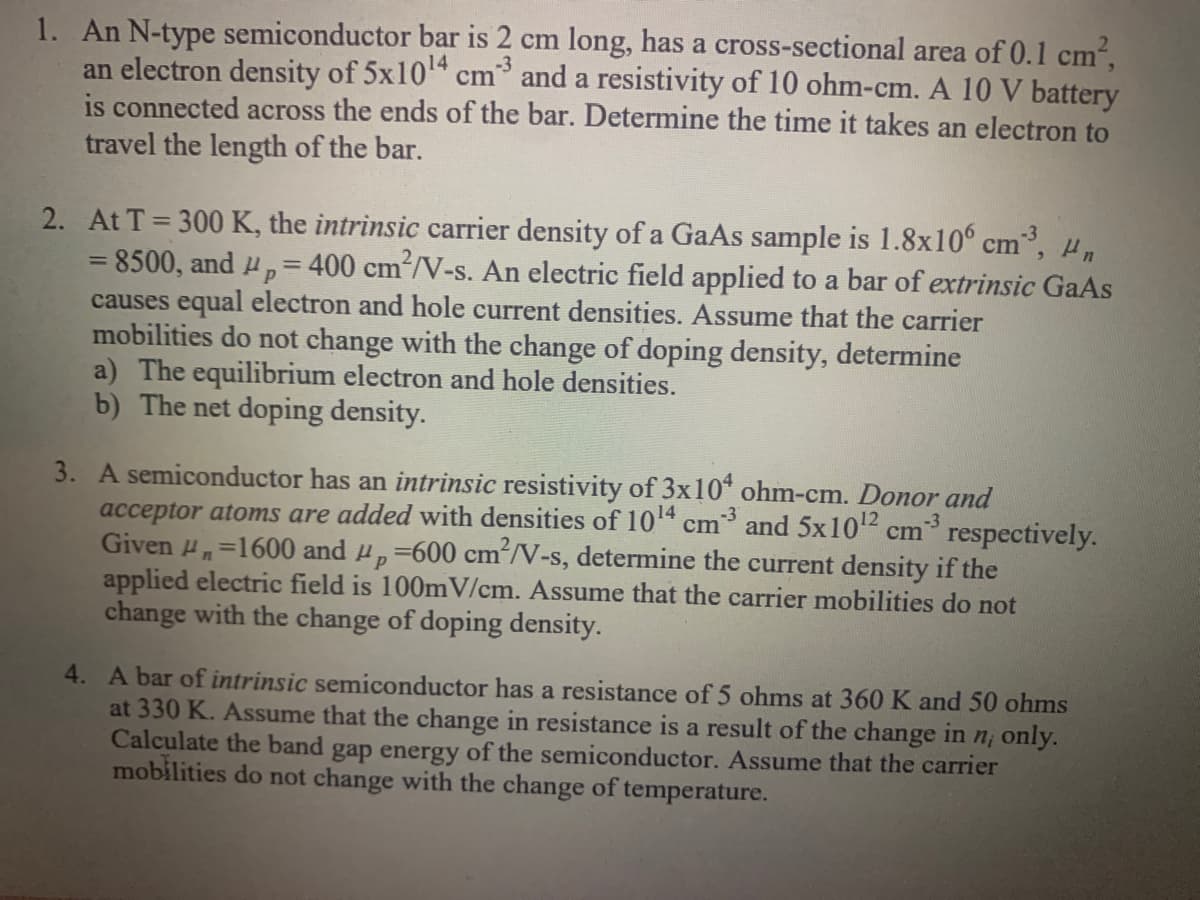1. An N-type semiconductor bar is 2 cm long, has a cross-sectional area of 0.1 cm², an electron density of 5x10¹4 cm³3 and a resistivity of 10 ohm-cm. A 10 V battery is connected across the ends of the bar. Determine the time it takes an electron to travel the length of the bar. 2. At T = 300 K, the intrinsic carrier density of a GaAs sample is 1.8x106 cm³, Hn = 8500, and #₂ = 400 cm²/V-s. An electric field applied to a bar of extrinsic GaAs causes equal electron and hole current densities. Assume that the carrier mobilities do not change with the change of doping density, determine a) The equilibrium electron and hole densities. b) The net doping density. 3. A semiconductor has an intrinsic resistivity of 3x104 ohm-cm. Donor and acceptor atoms are added with densities of 10¹4 cm³ and 5x10¹2 cm³ Given =1600 and #p=600 cm²/V-s, determine the current density if the respectively. applied electric field is 100mV/cm. Assume that the carrier mobilities do not change with the change of doping density. 4. A bar of intrinsic semiconductor has a resistance of 5 ohms at 360 K and 50 ohms at 330 K. Assume that the change in resistance is a result of the change in n, only. Calculate the band gap energy of the semiconductor. Assume that the carrier mobilities do not change with the change of temperature.
1. An N-type semiconductor bar is 2 cm long, has a cross-sectional area of 0.1 cm², an electron density of 5x10¹4 cm³3 and a resistivity of 10 ohm-cm. A 10 V battery is connected across the ends of the bar. Determine the time it takes an electron to travel the length of the bar. 2. At T = 300 K, the intrinsic carrier density of a GaAs sample is 1.8x106 cm³, Hn = 8500, and #₂ = 400 cm²/V-s. An electric field applied to a bar of extrinsic GaAs causes equal electron and hole current densities. Assume that the carrier mobilities do not change with the change of doping density, determine a) The equilibrium electron and hole densities. b) The net doping density. 3. A semiconductor has an intrinsic resistivity of 3x104 ohm-cm. Donor and acceptor atoms are added with densities of 10¹4 cm³ and 5x10¹2 cm³ Given =1600 and #p=600 cm²/V-s, determine the current density if the respectively. applied electric field is 100mV/cm. Assume that the carrier mobilities do not change with the change of doping density. 4. A bar of intrinsic semiconductor has a resistance of 5 ohms at 360 K and 50 ohms at 330 K. Assume that the change in resistance is a result of the change in n, only. Calculate the band gap energy of the semiconductor. Assume that the carrier mobilities do not change with the change of temperature.
Introductory Circuit Analysis (13th Edition)
13th Edition
ISBN:9780133923605
Author:Robert L. Boylestad
Publisher:Robert L. Boylestad
Chapter1: Introduction
Section: Chapter Questions
Problem 1P: Visit your local library (at school or home) and describe the extent to which it provides literature...
Related questions
Question
100%
Can you help show the step for questions #1

Transcribed Image Text:1. An N-type semiconductor bar is 2 cm long, has a cross-sectional area of 0.1 cm²,
an electron density of 5x10¹4 cm³ and a resistivity of 10 ohm-cm. A 10 V battery
is connected across the ends of the bar. Determine the time it takes an electron to
travel the length of the bar.
2. At T = 300 K, the intrinsic carrier density of a GaAs sample is 1.8x106 cm³, "n
= 8500, and p = 400 cm²/V-s. An electric field applied to a bar of extrinsic GaAs
causes equal electron and hole current densities. Assume that the carrier
mobilities do not change with the change of doping density, determine
a) The equilibrium electron and hole densities.
b) The net doping density.
3. A semiconductor has an intrinsic resistivity of 3x10 ohm-cm. Donor and
acceptor atoms are added with densities of 10¹4 cm³ and 5x10¹² cm³ respectively.
Given #₁=1600 and #p=600 cm²/V-s, determine the current density if the
applied electric field is 100mV/cm. Assume that the carrier mobilities do not
change with the change of doping density.
4. A bar of intrinsic semiconductor has a resistance of 5 ohms at 360 K and 50 ohms
at 330 K. Assume that the change in resistance is a result of the change in n, only.
Calculate the band gap energy of the semiconductor. Assume that the carrier
mobilities do not change with the change of temperature.
Expert Solution
This question has been solved!
Explore an expertly crafted, step-by-step solution for a thorough understanding of key concepts.
Step by step
Solved in 2 steps with 2 images

Knowledge Booster
Learn more about
Need a deep-dive on the concept behind this application? Look no further. Learn more about this topic, electrical-engineering and related others by exploring similar questions and additional content below.Recommended textbooks for you

Introductory Circuit Analysis (13th Edition)
Electrical Engineering
ISBN:
9780133923605
Author:
Robert L. Boylestad
Publisher:
PEARSON

Delmar's Standard Textbook Of Electricity
Electrical Engineering
ISBN:
9781337900348
Author:
Stephen L. Herman
Publisher:
Cengage Learning

Programmable Logic Controllers
Electrical Engineering
ISBN:
9780073373843
Author:
Frank D. Petruzella
Publisher:
McGraw-Hill Education

Introductory Circuit Analysis (13th Edition)
Electrical Engineering
ISBN:
9780133923605
Author:
Robert L. Boylestad
Publisher:
PEARSON

Delmar's Standard Textbook Of Electricity
Electrical Engineering
ISBN:
9781337900348
Author:
Stephen L. Herman
Publisher:
Cengage Learning

Programmable Logic Controllers
Electrical Engineering
ISBN:
9780073373843
Author:
Frank D. Petruzella
Publisher:
McGraw-Hill Education

Fundamentals of Electric Circuits
Electrical Engineering
ISBN:
9780078028229
Author:
Charles K Alexander, Matthew Sadiku
Publisher:
McGraw-Hill Education

Electric Circuits. (11th Edition)
Electrical Engineering
ISBN:
9780134746968
Author:
James W. Nilsson, Susan Riedel
Publisher:
PEARSON

Engineering Electromagnetics
Electrical Engineering
ISBN:
9780078028151
Author:
Hayt, William H. (william Hart), Jr, BUCK, John A.
Publisher:
Mcgraw-hill Education,